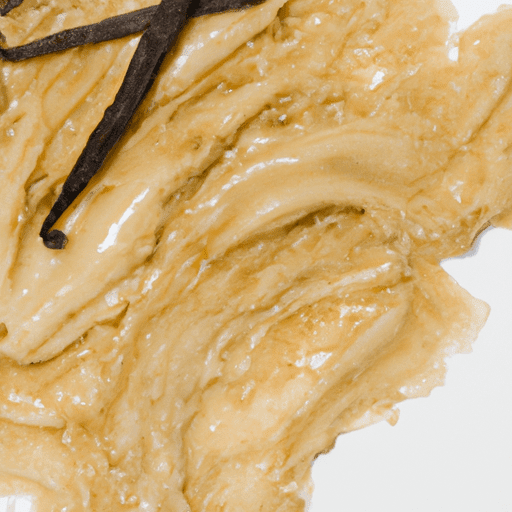The Versatility of Vanilla Bean Paste: A Culinary Delight
If you have ever embarked on a culinary adventure, you have probably come across a tiny jar of magical goodness called vanilla bean paste. This delightful ingredient is a staple in many kitchens, adding depth and complexity to a wide array of dishes. In this blog post, we will explore the tantalizing taste, common culinary uses, nutritional value, and fascinating history behind vanilla bean paste.
Unleashing the Flavors
Vanilla bean paste is a culinary gem that represents the perfect harmony of sweet and floral notes. Continuing the legacy of vanilla pods, it provides a concentrated burst of vanilla flavor, highlighting both its luscious creaminess and comforting warmth. The intense aroma is simply irresistible, making it a must-have in any food lover’s pantry.
Countless Culinary Possibilities
The culinary repertoire of vanilla bean paste extends far beyond the realm of desserts. While it undoubtedly lends itself to creating heavenly cakes, cookies, and custards, its versatility spans both sweet and savory realms. Add a rich undertone by incorporating it into homemade ice cream or elevate your morning pancakes with a subtle hint of this exquisite flavor. When paired with seafood or poultry, it enhances their natural flavors, offering a touch of sophistication to your palate.
Nutritional Value in Every Bite
Vanilla bean paste not only delights our taste buds but also provides some surprising health benefits. While it is not a significant source of any particular nutrient, it does contain trace amounts of calcium, potassium, magnesium, and iron. Additionally, it boasts antioxidant properties, potentially contributing to overall well-being. Just remember to indulge in moderation, as it is primarily used to enhance flavor rather than serve as a substantial nutritional component.
A History as Rich as Its Flavor
The story of vanilla bean paste intertwines with the intricate tapestry of history. Native to Mexico, vanilla was first cultivated by the ancient Aztecs, who treasured its exceptional taste and intoxicating aroma. After conquering the Aztec empire, the Spanish conquistadors introduced vanilla to Europe in the 16th century. Vanilla soon captured the hearts of food enthusiasts across the continent, leading to its spread throughout the world. Today, the tropical regions of Madagascar, Tahiti, and Réunion are among the leading producers of vanilla beans used for creating this precious paste.
An Essential Ingredient for Food Lovers
As you embark on your culinary endeavors, don’t forget to embrace the wonders of vanilla bean paste. This seemingly humble ingredient possesses the power to elevate even the simplest of recipes to extraordinary heights. Whether you are baking a batch of cookies, crafting a savory sauce, or infusing a decadent dessert, this magical paste will undoubtedly add that extra touch of delight to your creations.
So, dear food enthusiasts, let your taste buds dance with joy as you embrace the versatility, nutritional value, and enchanting history behind vanilla bean paste. It’s time to take your cooking to new levels and indulge in the wonders of this magnificent culinary delight.
Vanilla Bean Paste
Origin: Vanilla bean paste is made from vanilla beans, which come from the vanilla plant (Vanilla planifolia). The plant is native to Mexico and was originally cultivated by the Totonac people. It later spread to other regions such as Tahiti and Madagascar.
Common Uses: Vanilla bean paste is often used as a substitute for vanilla extract, offering a rich and intense vanilla flavor. It is commonly used in baking, desserts, and sweet dishes, but can also be used to enhance the flavor of sauces, custards, and ice creams. It can be easily incorporated into recipes and provides visual appeal with its specks of vanilla bean.
Nutritional Benefits: Vanilla bean paste is primarily used for its flavor rather than its nutritional value. However, it contains a small amount of dietary fiber and potassium. It is low in calories and fat.
Unique Properties: Vanilla bean paste contains ground vanilla bean seeds suspended in a thick and syrupy liquid. The paste’s texture enables the seeds to blend well into recipes, ensuring a more even distribution of flavor throughout the dish. The paste also retains the distinctive aroma of vanilla beans.
Historical Significance: Vanilla has a long history of cultivation and usage. It was believed to be introduced to Europe by the Spanish conquistador Hernán Cortés, who encountered vanilla during his travels to Mexico. Initially, vanilla was primarily used by the Aztecs as a flavoring agent for chocolate drinks. Over time, it gained popularity in Europe and beyond, becoming one of the most widely used and appreciated flavors in the culinary world.
Please note that while vanilla bean paste is an ingredient that provides a concentrated vanilla flavor, it may contain additives or sweeteners, so always check the product label for specific ingredients and nutritional information.




Use the share button below if you liked it.
It makes me smile, when I see it.